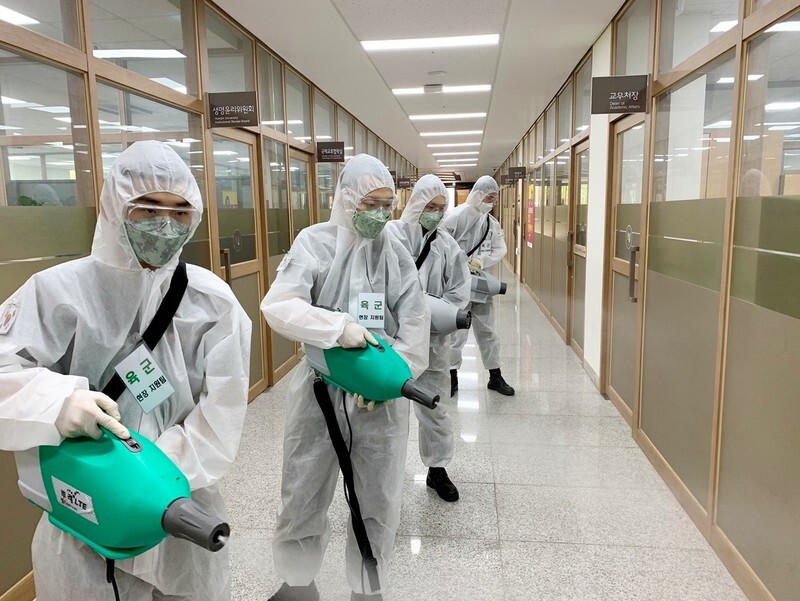hankyoreh
Links to other country sites 다른 나라 사이트 링크
Experts say S. Korea could experience second coronavirus outbreak this winter

South Korea’s disease control authorities warned that that while the coronavirus outbreak may fluctuate in severity for the time being, it could flare up again this winter.
“The advent of winter will bring an environment that’s optimal for viral transmission, which could lead to a major outbreak. Because COVID-19 is highly infectious and capable of transmission with mild or even no symptoms, it probably won’t be defeated in the near future,” said Jung Eun-kyeong, director of the Korea Centers for Disease Control and Prevention (KCDC), during the daily press briefing on Apr. 20.
Jung also addressed the possibility of COVID-19 becoming a seasonal disease. “Before making that judgment, we’ll have to watch for the formation of immunity and the progress of the outbreak. There is a possibility, however, that the outbreak will continue for a year or even several years.”
Even if the COVID-19 outbreak is halted inside South Korea, strict measures may have to remain in place for a long time if the outbreak continues overseas. The latest figures from the KCDC show that 13 new cases were reported on Sunday and nine were reported the following day, bringing the cumulative total to 10,683. More than a thousand (1,011) of those cases were imported from other countries, representing 9.46% of the total. Though the number of imported cases surged in late March and early April, experts say that number was brought down by tough quarantine measures and entrance restrictions.
The first COVID-19 case was brought to South Korea from China on Jan. 20. Since then, there was a surge of imported cases from Europe in March and from the US in April. Between Mar. 22 and Apr. 4, imported cases made up 61.7% of total cases. According to analysts at the KCDC, 61 patients from overseas have passed along the disease to 157 people on the local level.
“I think it’s very lucky that we haven’t seen a single infection over the past three months among the more than 70,000 full-time workers who are in charge of quarantine and special entrance protocols at Incheon International Airport,” Jung said.
As the number of new cases decreases and more and more patients are cured and released from quarantine, the government has suspended operation of 11 of the 16 residential treatment centers it set up in Daegu and North Gyeongsang Province to respond to the COVID-19 outbreak. Two other centers are being used to house patients arriving from overseas.
The government is planning to close the other five centers in the Daegu and North Gyeongsang Province in stages, with the last center shuttered by the end of the month. So far, 2,948 of the people being housed at the centers have been released following recovery, while 155 have been transferred to hospitals.
By Choi Ha-yan, staff reporter
Please direct comments or questions to [english@hani.co.kr]

Editorial・opinion
![[Column] The state is back — but is it in business? [Column] The state is back — but is it in business?](https://flexible.img.hani.co.kr/flexible/normal/500/300/imgdb/original/2024/0506/8217149564092725.jpg) [Column] The state is back — but is it in business?
[Column] The state is back — but is it in business?![[Column] Life on our Trisolaris [Column] Life on our Trisolaris](https://flexible.img.hani.co.kr/flexible/normal/500/300/imgdb/original/2024/0505/4817148682278544.jpg) [Column] Life on our Trisolaris
[Column] Life on our Trisolaris- [Editorial] Penalties for airing allegations against Korea’s first lady endanger free press
- [Editorial] Yoon must halt procurement of SM-3 interceptor missiles
- [Guest essay] Maybe Korea’s rapid population decline is an opportunity, not a crisis
- [Column] Can Yoon steer diplomacy with Russia, China back on track?
- [Column] Season 2 of special prosecutor probe may be coming to Korea soon
- [Column] Park Geun-hye déjà vu in Yoon Suk-yeol
- [Editorial] New weight of N. Korea’s nuclear threats makes dialogue all the more urgent
- [Guest essay] The real reason Korea’s new right wants to dub Rhee a founding father
Most viewed articles
- 1[Column] Why Korea’s hard right is fated to lose
- 2Amid US-China clash, Korea must remember its failures in the 19th century, advises scholar
- 3[Column] The state is back — but is it in business?
- 4[Column] Life on our Trisolaris
- 5[Guest essay] Maybe Korea’s rapid population decline is an opportunity, not a crisis
- 6OECD upgrades Korea’s growth forecast from 2.2% to 2.6%
- 7AI is catching up with humans at a ‘shocking’ rate
- 8[Column] Can Yoon steer diplomacy with Russia, China back on track?
- 9[Editorial] Yoon must halt procurement of SM-3 interceptor missiles
- 1060% of young Koreans see no need to have kids after marriage